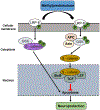Recent advances in nanotherapeutic strategies for spinal cord injury repair
- PMID: 30582938
- PMCID: PMC6959132
- DOI: 10.1016/j.addr.2018.12.011
Recent advances in nanotherapeutic strategies for spinal cord injury repair
Abstract
Spinal cord injury (SCI) is a devastating and complicated condition with no cure available. The initial mechanical trauma is followed by a secondary injury characterized by inflammatory cell infiltration and inhibitory glial scar formation. Due to the limitations posed by the blood-spinal cord barrier, systemic delivery of therapeutics is challenging. Recent development of various nanoscale strategies provides exciting and promising new means of treating SCI by crossing the blood-spinal cord barrier and delivering therapeutics. As such, we discuss different nanomaterial fabrication methods and provide an overview of recent studies where nanomaterials were developed to modulate inflammatory signals, target inhibitory factors in the lesion, and promote axonal regeneration after SCI. We also review emerging areas of research such as optogenetics, immunotherapy and CRISPR-mediated genome editing where nanomaterials can provide synergistic effects in developing novel SCI therapy regimens, as well as current efforts and barriers to clinical translation of nanomaterials.
Keywords: Nanomaterials; Nanotechnology; Regenerative medicine; Spinal cord injury.
Copyright © 2018. Published by Elsevier B.V.
Figures







References
-
- Bawa R, Audette GF, Rubinstein I, Handbook of Clinical Nanomedicine: Nanoparticles, Imaging, Therapy, and Clinical APplications, Pan Stanford Publishing, 2016.
Publication types
MeSH terms
Substances
Grants and funding
LinkOut - more resources
Full Text Sources
Medical
Research Materials

